Numerical Study on Peak Shaving Performance of Combined Heat and Power Unit Assisted by Heating Storage in Long-Distance Pipelines Scheduled by Particle Swarm Optimization Method
Abstract
:1. Introduction
2. Dynamic Simulation Model
2.1. Heat Transfer Model
2.2. Pressure Drop Model
2.3. Model of Turbine
2.4. Particle Swarm Optimization Method
3. Results
3.1. Reference Case
3.2. Performance Characteristics of Long-Distance Pipeline Thermal Energy Storage Component
3.3. Peak Shaving Performance Optimization
4. Conclusions
Author Contributions
Funding
Data Availability Statement
Conflicts of Interest
Nomenclature
| Symbol | Description | Unit |
| coal consumption rate | kg/s | |
| acceleration coefficients | - | |
| specific heat capacity | J/(kg °C) | |
| diameter | m | |
| exergy | J | |
| heat exchange area | m2 | |
| objective function | - | |
| heating water flow rate | kg/s | |
| enthalpy | kJ/kg | |
| heat transfer coefficient | W/(m2 °C) | |
| length | m | |
| total number of particles | - | |
| pressure | Pa | |
| pressure loss | Pa | |
| electric power | MW | |
| heating power | MW | |
| lower heating value | MJ/kg | |
| thermal resistance | m2 °C/W | |
| temperature | °C | |
| time | s | |
| time step | s | |
| burial depth of the heating pipeline | m | |
| Matrix | ||
| global particle position | ||
| personal particle position | ||
| random vector | ||
| particle velocity | ||
| particle position | ||
| Greek Symbols | ||
| heat release coefficient | W/(m2 °C) | |
| local heat loss coefficient | % | |
| density of fluid | kg/m3 | |
| thermal conductivity | W/(m °C) | |
| equivalent absolute roughness of wall | m | |
| inertia weight | ||
| Subscripts and superscripts | ||
| before stage group | ||
| after stage group | ||
| basic working condition | ||
| best particle | ||
| circulation water | ||
| comprehensive | ||
| condenser | ||
| time delay | ||
| energy utilization | ||
| exergy | ||
| exhaust steam flow | ||
| friction | ||
| the i node or the i particle | ||
| inner wall | ||
| inlet of a node | ||
| outer wall of insulation layer | ||
| local | ||
| the n time level | ||
| current time level | ||
| outer wall | ||
| outlet of a node | ||
| heating pipeline | ||
| return water in heating pipeline | ||
| soil | ||
| supply water in heating pipeline | ||
| Abbreviations | ||
| CCHP | combined cooling, heating and power | |
| CHP | combined heat and power | |
| HHV | high heat value | |
| LHV | low heat value | |
| PSO | particle swarm optimization | |
| TES | thermal energy storage | |
References
- Liu, S.; Shen, J. Modeling of Large-Scale Thermal Power Plants for Performance Prediction in Deep Peak Shaving. Energies 2022, 15, 3171. [Google Scholar] [CrossRef]
- Li, Y.; Sun, F.; Zhang, Q.; Chen, X.; Yuan, W. Numerical Simulation Study on Structure Optimization and Performance Improvement of Hot Water Storage Tank in CHP System. Energies 2020, 13, 4734. [Google Scholar] [CrossRef]
- Wang, B.; Ma, H.; Ren, S.; Si, F. Effects of integration mode of the molten salt heat storage system and its hot storage temperature on the flexibility of a subcritical coal-fired power plant. J. Energy Storage 2023, 58, 106410. [Google Scholar] [CrossRef]
- Mostafavi Tehrani, S.S.; Saffar-Avval, M.; Behboodi Kalhori, S.; Mansoori, Z.; Sharif, M. Hourly energy analysis and feasibility study of employing a thermocline TES system for an integrated CHP and DH network. Energy Convers. Manag. 2013, 68, 281–292. [Google Scholar] [CrossRef]
- Brown, A.; Foley, A.; Laverty, D.; McLoone, S.; Keatley, P. Heating and cooling networks: A comprehensive review of modelling approaches to map future directions. Energy 2022, 261, 125060. [Google Scholar] [CrossRef]
- Ryszard, Z.; Niemyjski, O. Influence of Different Operating Conditions of a District Heating and Cooling System on Heat Transportation Losses of a District Heating Network. IOP Conf. Ser. Mater. Sci. Eng. 2019, 471, 042019. [Google Scholar]
- Niemyjski, O.; Zwierzchowski, R. Impact of Water Temperature Changes on Water Loss Monitoring in Large District Heating Systems. Energies 2021, 14, 2060. [Google Scholar] [CrossRef]
- Liu, M.; Ma, G.; Wang, S.; Wang, Y.; Yan, J. Thermo-economic comparison of heat–power decoupling technologies for combined heat and power plants when participating in a power-balancing service in an energy hub. Renew. Sust. Energy Rev. 2021, 152, 111715. [Google Scholar] [CrossRef]
- Liu, M.; Liu, M.; Chen, W.; Yan, J. Operational flexibility and operation optimization of CHP units supplying electricity and two-pressure steam. Energy 2023, 263, 125988. [Google Scholar] [CrossRef]
- Ye, L.; Yu, H.; Wang, M.; Wang, Q.; Tian, W.; Qiu, S.; Su, G.H. CFD/RELAP5 coupling analysis of the ISP No. 43 boron dilution experiment. Nucl. Eng. Technol. 2022, 54, 97–109. [Google Scholar] [CrossRef]
- Wang, J.; Jing, Y.; Zhang, C. Optimization of capacity and operation for CCHP system by genetic algorithm. Appl. Energy 2010, 87, 1325–1335. [Google Scholar] [CrossRef]
- Franco, A.; Versace, M. Multi-objective optimization for the maximization of the operating share of cogeneration system in District Heating Network. Energy Convers. Manag. 2017, 139, 33–44. [Google Scholar] [CrossRef]
- Zheng, X.; Wu, G.; Qiu, Y.; Zhan, X.; Shah, N.; Li, N.; Zhao, Y. A MINLP multi-objective optimization model for operational planning of a case study CCHP system in urban China. Appl. Energy 2018, 210, 1126–1140. [Google Scholar] [CrossRef]
- Martínez-Lera, S.; Ballester, J.; Martínez-Lera, J. Analysis and sizing of thermal energy storage in combined heating, cooling and power plants for buildings. Appl. Energy 2013, 106, 127–142. [Google Scholar] [CrossRef]
- Pérez-Iribarren, E.; González-Pino, I.; Azkorra-Larrinaga, Z.; Gómez-Arriarán, I. Optimal design and operation of thermal energy storage systems in micro-cogeneration plants. Appl. Energy 2020, 265, 114769. [Google Scholar] [CrossRef]
- Kaliatka, A.; Vaišnoras, M.; Valinčius, M.; Kaliatka, T. RELAP5 application for water hammer analysis in different thermal-hydraulic systems. Int. J. Thermofluids 2022, 14, 100154. [Google Scholar] [CrossRef]
- Bastida, H.; Oo, C.E.U.; Abyesekera, M.; Qadrdan, M. Modelling and control of district heating networks with reduced pump utilisation. IET Energy Syst. Integr. 2021, 3, 13–25. [Google Scholar] [CrossRef]
- Zhong, W.; Chen, J.; Zhou, Y.; Li, Z.; Lin, X. Network flexibility study of urban centralized heating system: Concept, modeling and evaluation. Energy 2019, 177, 334–346. [Google Scholar] [CrossRef]
- Wang, H.; Meng, H. Improved thermal transient modeling with new 3-order numerical solution for a district heating network with consideration of the pipe wall’s thermal inertia. Energy 2018, 160, 171–183. [Google Scholar] [CrossRef]
- Hou, Y.; Chen, P.; Jin, Y.; Zhang, C.; Li, W.; Gao, C.; Xiang, Y. Performance analysis of a small lead-cooled fast reactor coupled with a copper-chloride cycle hydrogen production system. Int. J. Hydrogen Energy 2024, 49, 1538–1549. [Google Scholar] [CrossRef]
- Wang, J.; Zong, Y.; You, S.; Træholt, C. A review of Danish integrated multi-energy system flexibility options for high wind power penetration. Clean Energy 2017, 1, 23–35. [Google Scholar] [CrossRef]
- Zheng, W.; Lu, H.; Zhang, M.; Wu, Q.; Hou, Y.; Zhu, J. Distributed Energy Management of Multi-Entity Integrated Electricity and Heat Systems: A Review of Architectures, Optimization Algorithms, and Prospects. IEEE Trans. Smart Grid 2023, 1. [Google Scholar] [CrossRef]
- Eberhart, R.; Kennedy, J. A New Optimizer using particle swarm theory. In Proceedings of the MHS’95. Proceedings of the Sixth International Symposium on Micro Machine and Human Science, Nagoya, Japan, 4–6 October 1995; pp. 39–43. [Google Scholar]
- Wang, Z.; Gu, Y.; Zhao, Z.; Lu, S. Operational optimization on large-scale combined heat and power units with low-pressure cylinder near-zero output. Energy Sci. Eng. 2023, 11, 2081–2095. [Google Scholar] [CrossRef]

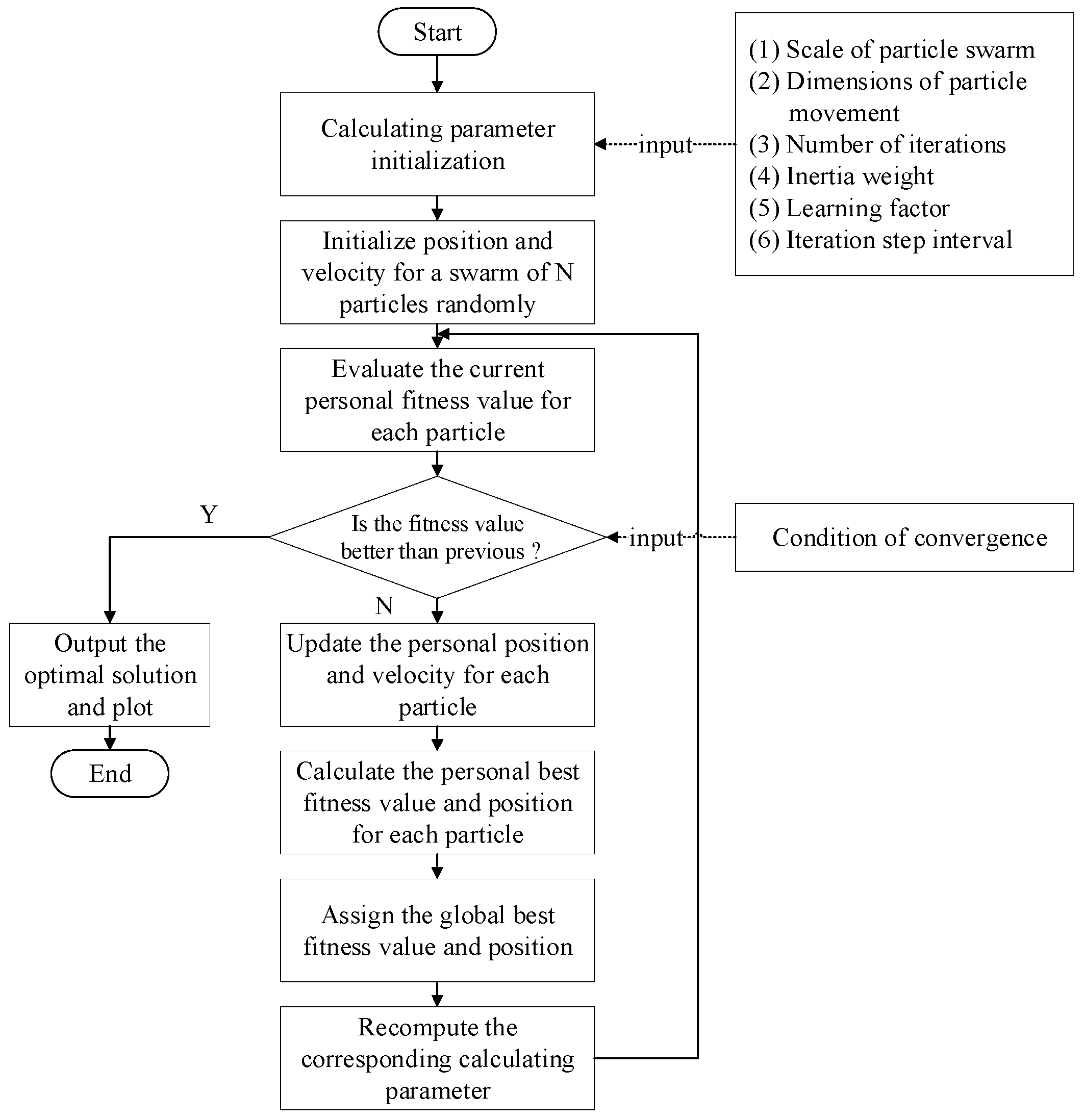

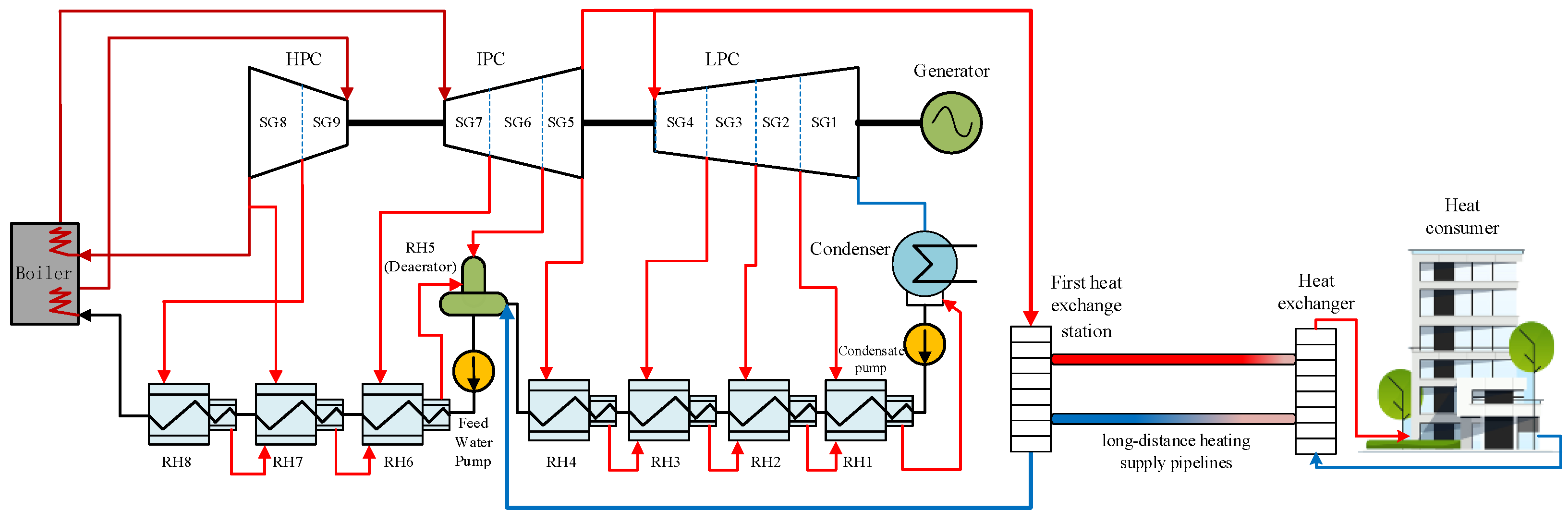




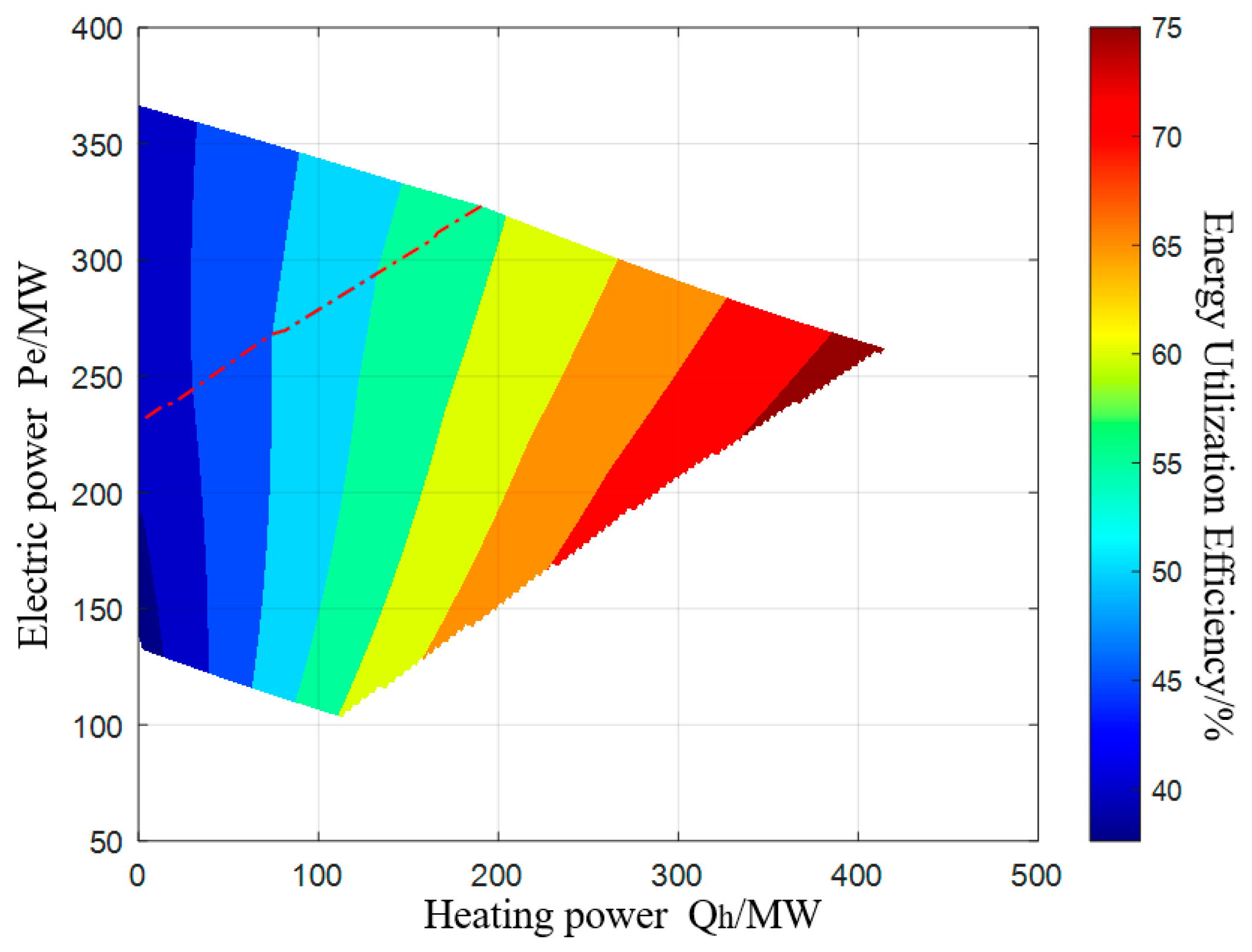
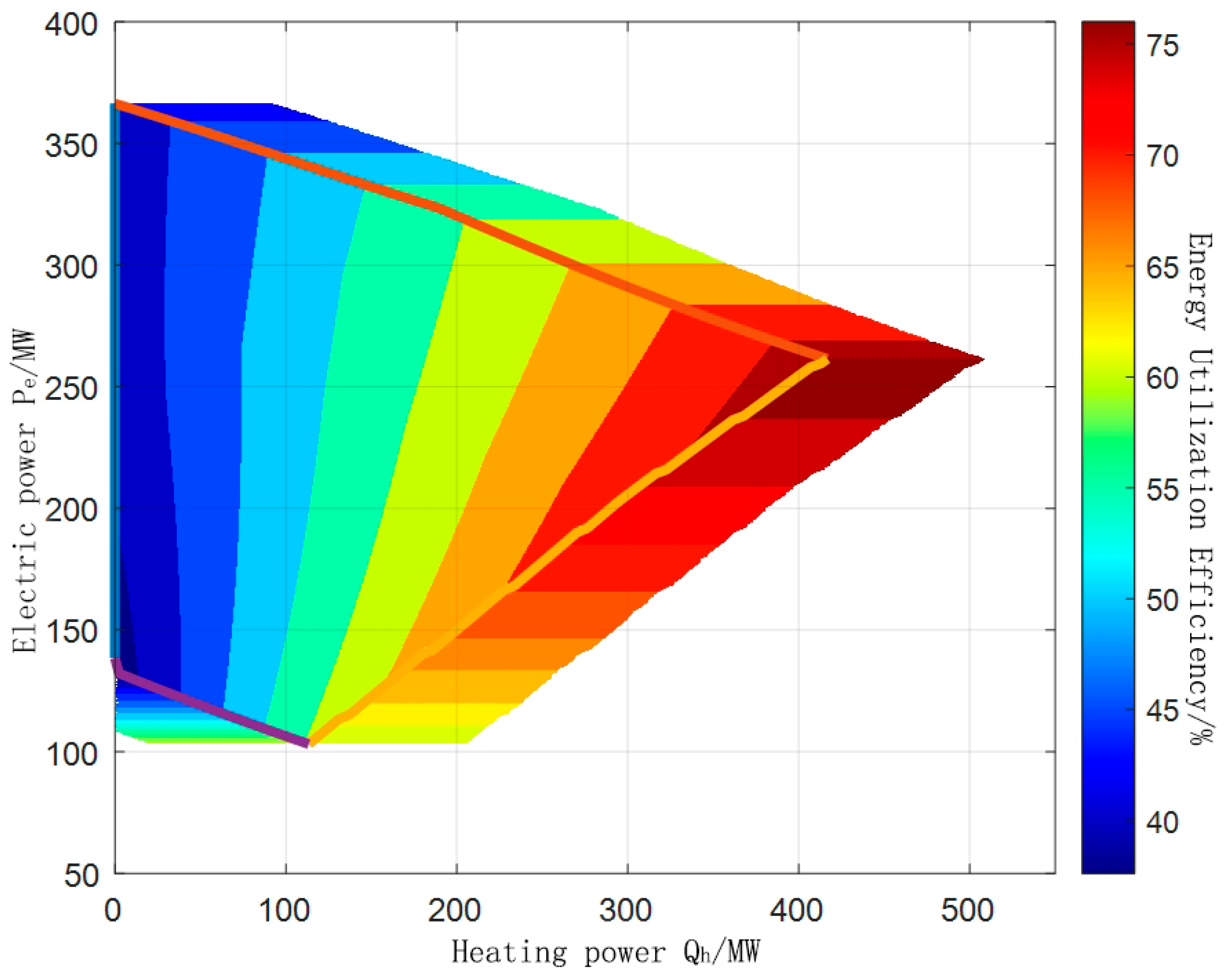



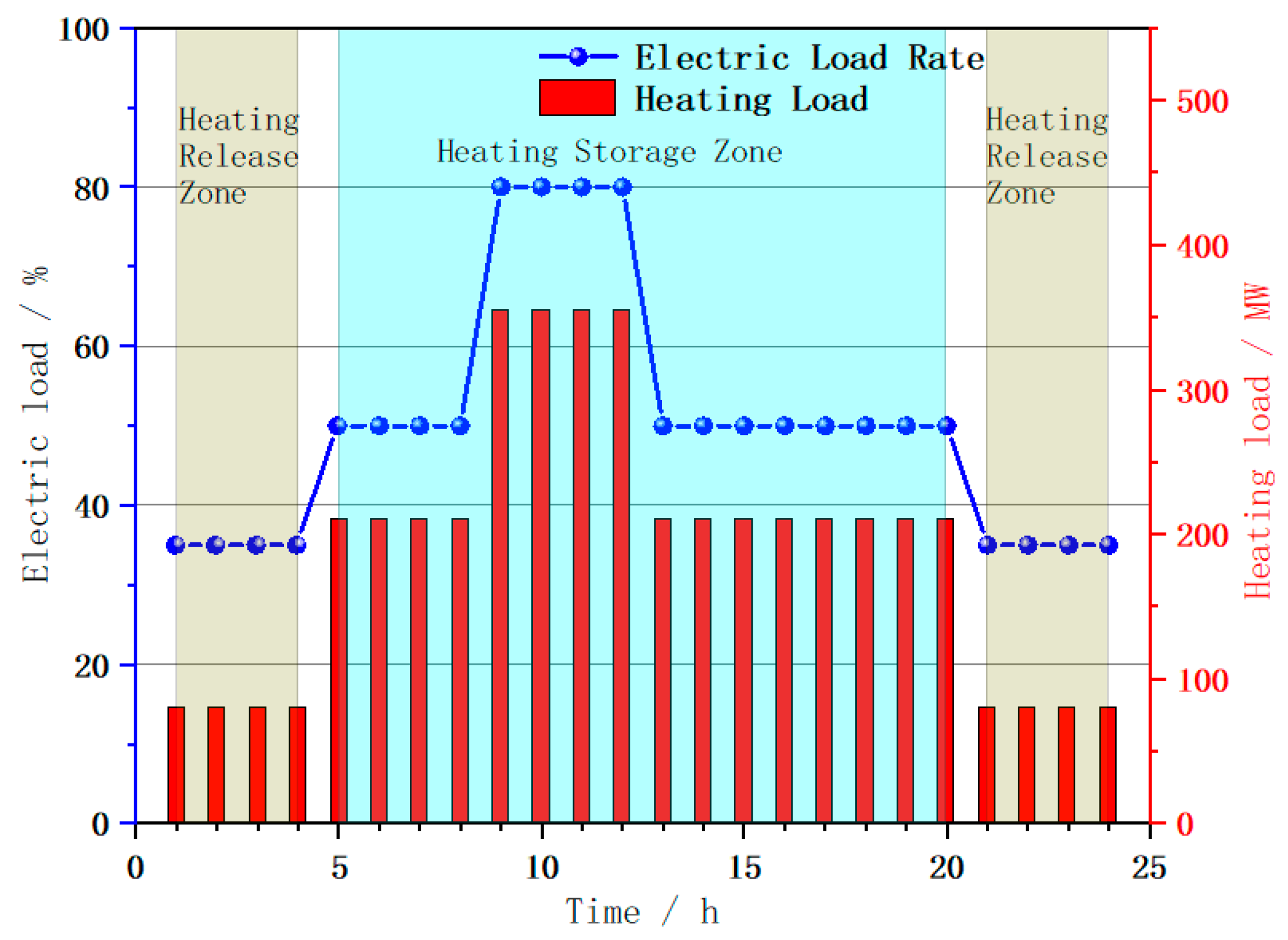
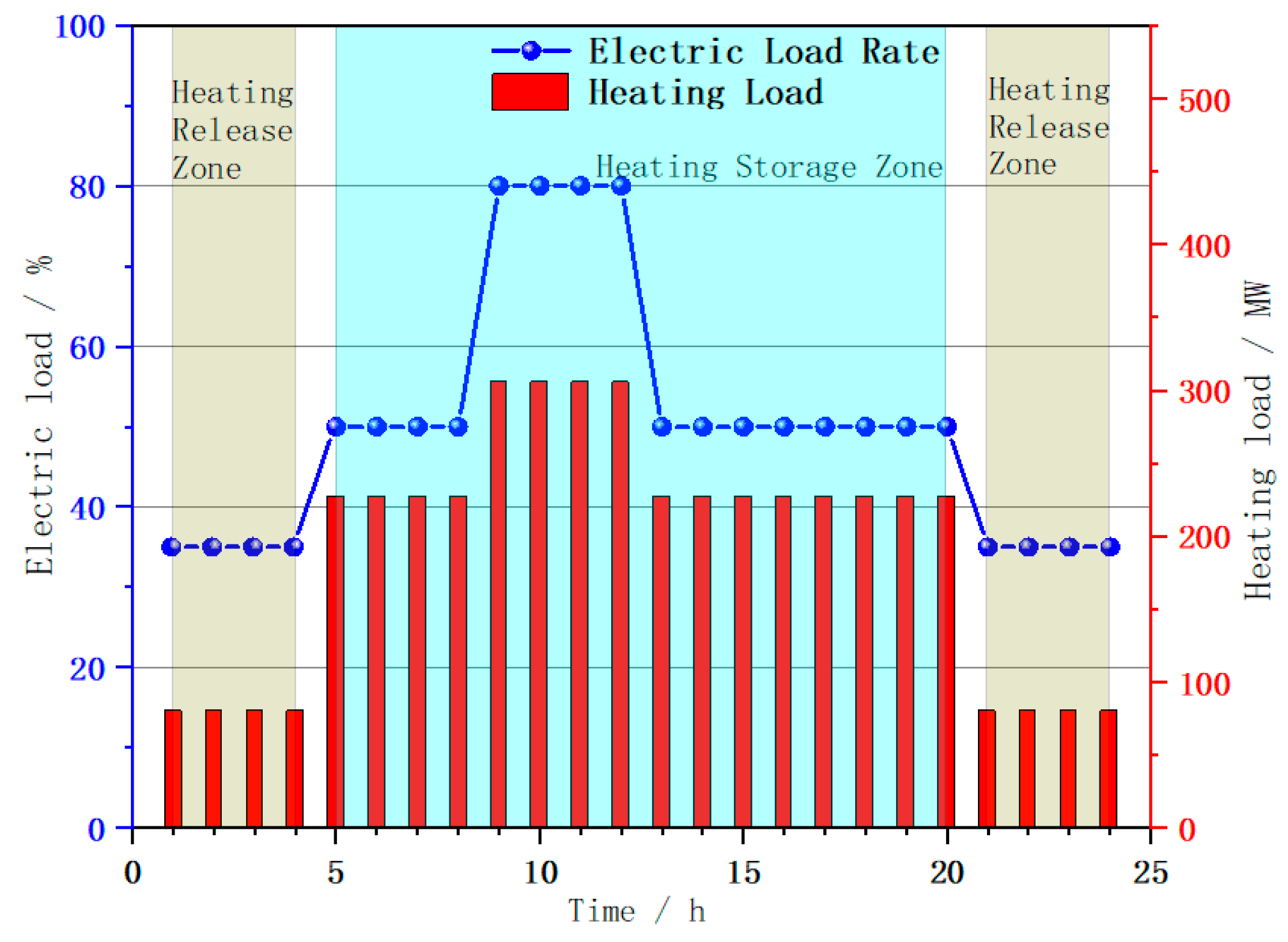
| Parameter | Value |
|---|---|
| Power of first heat exchange station, MW | 390.88 |
| Power of heat exchanger, MW | 325.73 |
| Water flow velocity, m·s−1 | 0.87 |
| Pipe diameter, m | 1.80 |
| Outlet temperature of first heat exchange station, °C | 75.00 |
| Outlet pressure of first heat exchange station, MPa | 1.00 |
| Inlet temperature of first heat exchange station, °C | 39.30 |
| Inlet pressure of first heat exchange station, MPa | 0.52 |
| Inlet temperature of heat exchanger, °C | 73.50 |
| Inlet pressure of heat exchanger, MPa | 0.76 |
| Outlet temperature of heat exchanger, °C | 40.00 |
| Flow Period (h) | Time for Warming Up (h) | Response Time (h) | |
|---|---|---|---|
| 10 km feedwater pipe | 0.64 | 1.69 | 2.33 |
| 10 km return pipe | 3.83 | 2.95 | 6.78 |
| 15 km feedwater pipe | 0.96 | 1.98 | 2.94 |
| 15 km return pipe | 5.75 | 4.47 | 10.22 |
| 20 km feedwater pipe | 1.28 | 2.26 | 3.54 |
| 20 km return pipe | 7.66 | 5.69 | 13.35 |
| Time for Warming Up (h) | |
|---|---|
| 70 °C IC feedwater pipe | 2.50 |
| 70 °C IC return pipe | 3.98 |
| 75 °C IC feedwater pipe | 2.61 |
| 75 °C IC return pipe | 4.70 |
| 80 °C IC feedwater pipe | 2.72 |
| 80 °C IC return pipe | 5.01 |
| Energy Utilization Efficiency (%) | Exergy Efficiency (%) | |
|---|---|---|
| Case I: local maximum efficiency | 63.65 | 56.67 |
| Case II | 64.05 | 56.70 |
| Case III: PSO-optimized case | 64.40 | 56.73 |
Disclaimer/Publisher’s Note: The statements, opinions and data contained in all publications are solely those of the individual author(s) and contributor(s) and not of MDPI and/or the editor(s). MDPI and/or the editor(s) disclaim responsibility for any injury to people or property resulting from any ideas, methods, instructions or products referred to in the content. |
© 2024 by the authors. Licensee MDPI, Basel, Switzerland. This article is an open access article distributed under the terms and conditions of the Creative Commons Attribution (CC BY) license (https://creativecommons.org/licenses/by/4.0/).
Share and Cite
Ju, H.; Wang, Y.; Feng, Y.; Zheng, L. Numerical Study on Peak Shaving Performance of Combined Heat and Power Unit Assisted by Heating Storage in Long-Distance Pipelines Scheduled by Particle Swarm Optimization Method. Energies 2024, 17, 492. https://doi.org/10.3390/en17020492
Ju H, Wang Y, Feng Y, Zheng L. Numerical Study on Peak Shaving Performance of Combined Heat and Power Unit Assisted by Heating Storage in Long-Distance Pipelines Scheduled by Particle Swarm Optimization Method. Energies. 2024; 17(2):492. https://doi.org/10.3390/en17020492
Chicago/Turabian StyleJu, Haoran, Yongxue Wang, Yiwu Feng, and Lijun Zheng. 2024. "Numerical Study on Peak Shaving Performance of Combined Heat and Power Unit Assisted by Heating Storage in Long-Distance Pipelines Scheduled by Particle Swarm Optimization Method" Energies 17, no. 2: 492. https://doi.org/10.3390/en17020492




